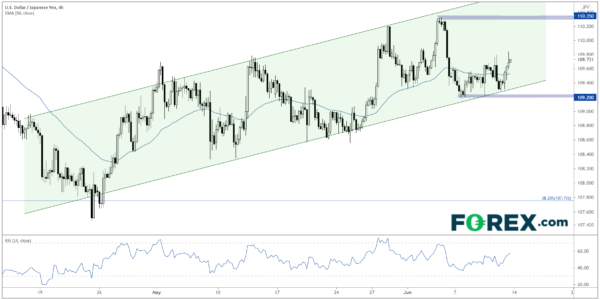Traders often discuss central bank “decisions” as a major event risk, but when it comes to Wednesday’s Federal Reserve meeting, there’s really no immediate decision to be made. The FOMC will almost certainly leave interest rates unchanged in the 0.00%-0.25% range and make no changes to its ongoing asset purchases this month. Therefore, the market reaction will hinge on any changes to the statement, the economic forecasts in the Summary of Economic Projections (SEP), and of course, the tone of Fed Chairman Powell’s post-meeting press conference.
As always, it helps to analyze the meeting through the lens of the Fed’s dual mandate: Price stability (inflation) and maximum sustainable employment:
Mandate #1: Inflation
As we highlighted yesterday, US inflation is running at its highest level in decades, fulfilling the Fed’s expectations of rising price pressures as the economy reopens. The critical question now is whether this elevated rate of inflation is “transitory” or whether higher prices risk becoming psychologically entrenched.
On balance, we believe the central bank will be able to point to supply chain distortions, base effects from last year’s COVID-induced price declines, and pent-up demand as the primary, temporary catalysts for higher inflation readings. But if we see inflation continue to run hot over the next couple of months, Jerome Powell and company will start to feel the pressure to taper sooner and more aggressively, even if consumer and labor market data keeps coming in soft.
Mandate #2: Maximum Employment
Despite a sharp drop from its Q2 2020 peak, the 5.8% U3 unemployment rate still remains uncomfortably high and well above the Fed’s preferred target. More worryingly, the last two monthly Non-Farm Payrolls (NFP) reports have come in below expectations, averaging just a little over 400k net new jobs per month. While this rate of job growth may be acceptable in more normal times, the US labor market is still millions of jobs below its pre-COVID levels and only growing tepidly despite widespread vaccine distribution and economic “reopening” across the country.
In other words, the to-date lackluster labor market recovery following the COVID recession is the reason the central bank is continuing with its unprecedented stimulus measures, though it’s clear these measures are becoming less and less effectives at promoting employment growth. With the risks of inflation on the rise, we wouldn’t be surprised to see more discussion on the timeline for tapering asset purchases and the median Fed member’s expectations for (at least) an initial interest rate hike move forward to 2023 in this week’s meeting.
Currency pair to watch: USD/JPY
As a general rule of thumb, USD/JPY tends to be one of the “cleanest” major currency pairs to trade around US economic developments as both the US dollar and Japanese yen have well-earned reputations for being the “safe havens” of the global FX market.
As we go to press, USD/JPY has been rising in a bullish channel for two full months, and rates have bounced off the bottom of that channel in recent days. If the Fed strikes a more hawkish tone (by raising economic projections, moving forward the so-called “dots” for interest rate increases and/or hinting at more explicit discussions around the timeline for tapering), USD/JPY could extend its recent rains and retest the multi-month high near 110.35. Conversely, a more dovish outcome from the meeting could see USD/JPY revisit its June lows near 109.20 or even fall below 109.00 to break the established bullish channel.
Source: TradingView, StoneX
Even if there’s no immediate policy changes at this week’s meeting, it’s clear that traders will be more and more focused on the Federal Reserve as we move through the summer!


 Signal2forex.com - Best Forex robots and signals
Signal2forex.com - Best Forex robots and signals




